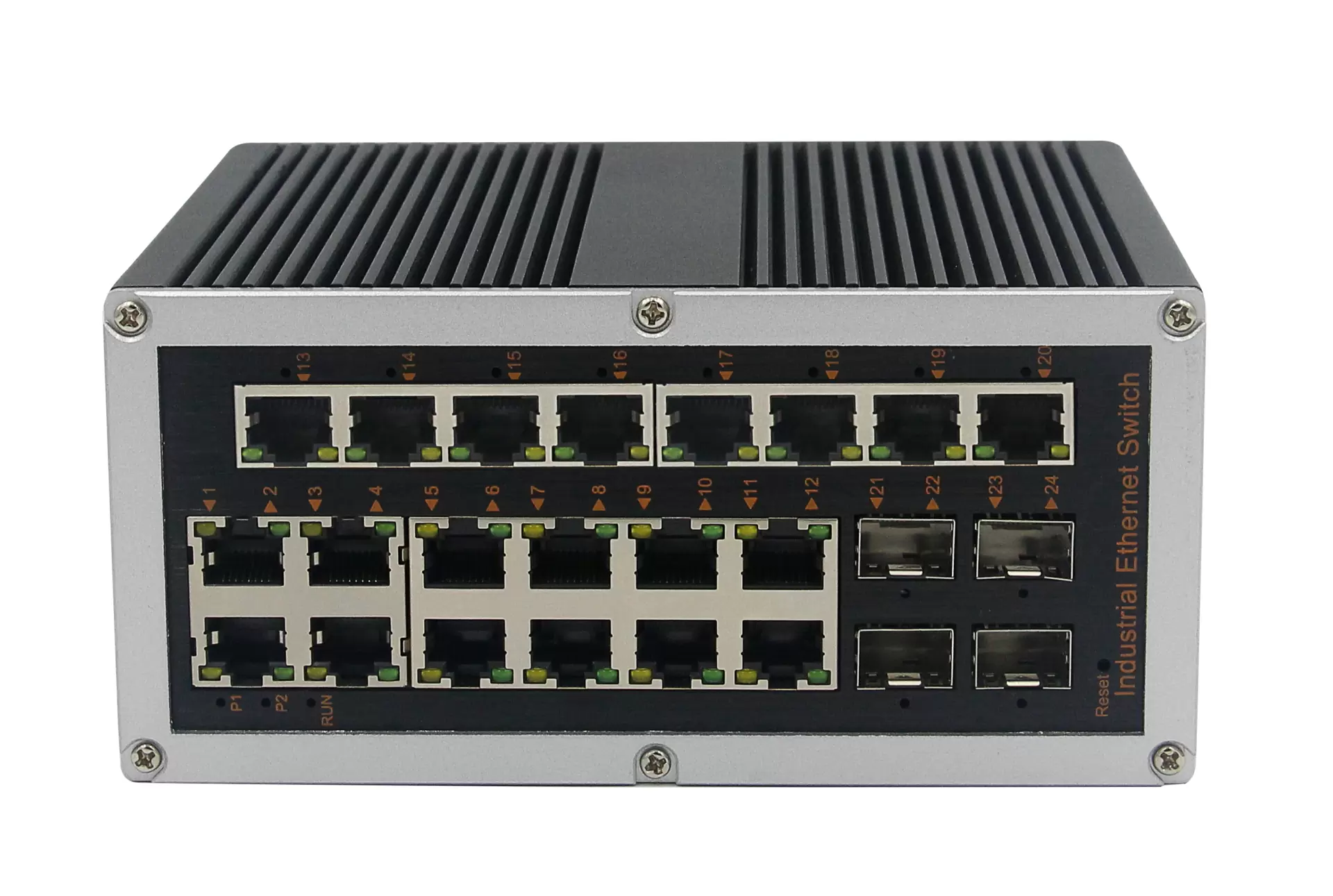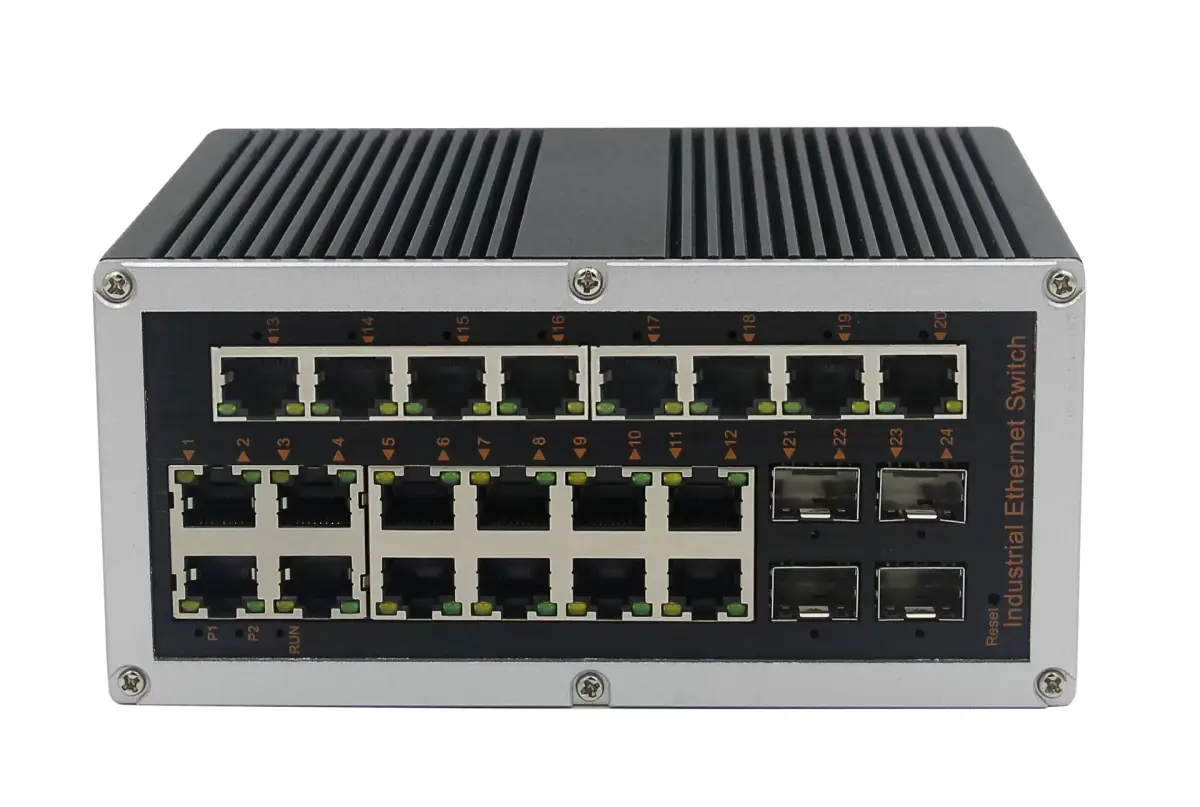.

[Industrial switch] The role of industrial switches The difference between industrial switches and ordinary switches
The role of industrial switches
Industrial Ethernet switches are mainly used for real-time Ethernet data transmission in complex industrial environments. During the design of Ethernet, because it adopts carrier sense multiplexing collision detection (CSMA/CD mechanism), it is applied in complex industrial environment, and its reliability is greatly reduced, so that Ethernet cannot be used. The industrial Ethernet switch adopts the storage conversion switching method, and at the same time improves the Ethernet communication speed, and has a built-in intelligent alarm design to monitor the network operation status, so as to ensure the reliable and stable operation of the Ethernet in the harsh and dangerous industrial environment.

( 24 Port gigaibt Industrial switch , included 4 port SFP uplink )
The difference between industrial switches and ordinary switches
The difference between industrial Ethernet switches and ordinary switches is mainly reflected in function and performance.
The functional difference mainly refers to: the industrial Ethernet switch is closer to the industrial network communication in function, such as the interconnection with various field buses, the redundancy of the equipment, and the real-time of the equipment;
The difference in performance is mainly reflected in the adaptation to the different parameters of the external environment. In addition to the harsh environments such as coal mines and ships, industrial environments also have special requirements in terms of EMI (electromagnetic compatibility), temperature, humidity, and dust-proofing. Among them, the influence of temperature on industrial network equipment is the most extensive.
Components: The selection of industrial Ethernet switch components is more demanding and can better meet the needs of industrial production sites.
Mechanical environment: Industrial Ethernet switches can better adapt to harsh mechanical environments, including vibration resistance, impact resistance, corrosion resistance, dustproof, waterproof, etc.
Climate environment: Industrial Ethernet switches can better adapt to poor climate environment, including temperature, humidity, etc.
Electromagnetic environment: Industrial Ethernet switches have strong anti-electromagnetic interference capabilities.
Working voltage: Industrial Ethernet switches have a wide range of working voltages, while ordinary switches have higher voltage requirements.
Power supply design: ordinary switches are basically single power supply, while industrial switch power supply is generally dual power supply for mutual backup.
Installation method: Industrial Ethernet switches can be installed in DIN rails, racks, etc., and ordinary switches are generally racks and desktops.
Heat dissipation method: Industrial Ethernet switches generally use fanless shells to dissipate heat, while ordinary switches use fans to dissipate heat.
The difference between industrial control switches and industrial switches
Generally speaking, switches generally refer to Ethernet switches (excluding program-controlled switches for telecommunications, otherwise the explanation is too complicated).
Ethernet switches are generally divided into: commercial (Ethernet) switches, industrial (Ethernet) switches, and home (Ethernet) switches.
Commercial switches are generally used in enterprise office networks and other occasions. They are generally rack-mounted and installed in enterprise computer rooms. They usually require high reliability, 24-hour uninterrupted long-term operation, large bandwidth, and many interfaces.
Industrial switches are generally used in industrial production occasions, and usually have various appearances and installation forms. According to different application occasions, there are requirements for waterproof, dustproof, shock resistance, and electromagnetic interference resistance. Of course, reliability requirements are also high, and they also need to run 24 hours a day for a long time. . Some automatic control applications require low forwarding delay, and some require redundant power supply, DC24V power supply and so on.
There are not many home switches now, so there is no need to introduce them.
The industrial control switch is actually not a standard name, it is a common name. Switches used in the industrial control industry are often industrial switches.
Standardly speaking, it is an industrial computer, a program-controlled switch, and a switch. These are three things
An industrial computer is an industrial PC, or a variant of a PC, which is mainly used to run special corresponding programs.
Program-controlled switchboard, this is very simple. It is a telephone switchboard. If the company wants to install switchboards and extensions, it needs this.
Of course, switches are used by PCs. Ethernet is a standard network protocol. All the networks we use now are Ethernet structures. All switches and Ethernet switches are the same thing. Generally, it is not called that. As for industrial switches, it should be different from home-use managed switches. In fact, this kind of product is not so clearly defined, and now there are only 2~300 switches that can be managed by the network, and it is no problem for home use.
The other is working hours. General industrial devices support 7*24, but now household equipment is often powered off forever, so there is no need to distinguish it so clearly.





